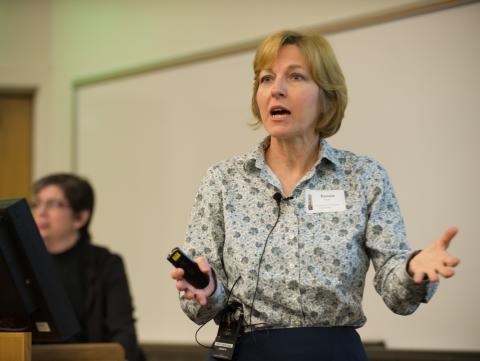The Center for 21st Century Universities recently assembled a team of “flipping veterans" to share successes and failures they’ve experienced in learning to flip a class.
Flipped and blended classrooms are gaining momentum at Georgia Tech. This method of instruction is exciting for many reasons — particularly because “flipping” provides instructors more time in class to work with students on coursework and concepts, leading to greater student mastery.
Yet, educators should be warned that a flipped class can easily turn into a “flopped class” if flipping isn’t approached carefully, and if significant time and preparation are not given to this method of instruction.
The Center for 21st Century Universities (C21U) recently assembled a team of “flipping veterans,” Bonnie Ferri from the School of Electrical and Computer Engineering, Don Webster from the School of Civil and Environmental Engineering, and Jung Choi from the College of Sciences, to share successes and failures they’ve experienced in learning to flip a class.
Why do educators value a flipped classroom?
The panelists agreed upon the fact that educators greatly value a flipped classroom because it allows for more hands-on or application-based project time, since students view lessons before class.
“One of the core benefits of flipping a classroom,” says Ferri, “is that it delivers lessons beforehand and allows students time to apply these lessons in class.”
Improved examination scores have been another across-the-board benefit of this new style of teaching for Ferri, Webster, and Choi.
“After I looked at the application questions in my exam data, I realized that the students in the flipped version of my class did better than those who were in the previous model,” says Choi.
What mistakes do educators make when planning to flip a class?
One of the greatest benefits of flipping is providing pre-recorded lessons for students to watch or engage with before class — but this can also become an educator’s greatest downfall when first learning how to flip a class.
All three faculty members have seen flipped courses fail because educators simply recorded their typical lecture materials and expected the format to translate to a flipped class.
“I realized that if I wasn’t going to record something that was better than a normal lecture, then what was the point?” says Webster.
Another major mistake made by faculty in a newly flipped course is to place too much time and emphasis on the out-of-class lectures, and not enough on the quality of the more flexible in-class interactions and projects.
“Recording the lecture video is less important,” says Choi. “It’s the in-class portion and what an instructor does with that time that really counts.”
What’s the best advice you would give to someone flipping a class for the first time?
Over and over, Ferri, Choi, and Webster asserted two important things to remember when flipping a class for the first time: Do not assume that a flipped class will be easier to manage or less work than a traditional class, and remember to ask for help.
“It’s tricky to successfully flip a class, and people can be discouraged easily without mentoring,” says Ferri. “A lot of times, a person teaching a newly flipped class will see their teacher ratings plummet because they just don’t know what they’re doing. So get a mentor.”
The panel of C21U faculty all concluded that if approached with planning, dedication, and mentorship, the experience of flipping a class is an opportunity for both student and instructor growth and success.
C21U provides resources and mentorship for those interested in flipped or blended classrooms. For resources and to find out more, explore C21U’s Guide to Flipping Your Classroom at www.c.gatech.edu/C21Uflipguide, or visit www.c21u.gatech.edu.
Additional Images


